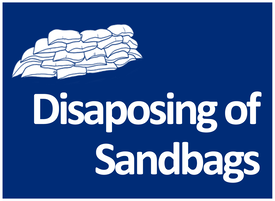
As water levels are subsiding, the risk to properties has been decreased. Please evaluate your property and whether the risk has decreased enough for flood protection measures to be removed.
In most instances, sand used for flood protection can be treated as clean soil and be used as general fill, substitute aggregate in construction applications or blended into gardens and lawns, if placed well away from watercourses.
Alternatively, residents can dispose of sandbags by returning them to the sandpile location at Municipal Hall at 7400 Prospect Street as long as they are not mixed with any other substance, wood debris, garbage or recycling materials. Alternatively, if the sandbags have not been exposed to flood water and the source of the sand is known to be uncontaminated, it can be treated as clean soil and can be used as general fill, substitute aggregate in construction applications or blended into gardens and lawns, if placed well away from watercourses.
Disposal of sandbags or sand near rivers, lakes, creeks or other watercourse is an offense and prohibited by the Water Sustainability Act. The impact can destroy fish habitat and affect infrastructure, flood control, navigation and recreational activities. You can use the sand on your own lawn or landscaping, if placed well away from watercourses. Report violations to Natural Resource at 1-877-952-7277, (Option 2) toll-free or #7277 on a cellphone.
Sandbag Handling Guidelines
The following are general guidelines for the handling of sandbags:
- Gloves and proper footwear should be worn when handling sandbags.
- After handling sandbags wash exposed body parts with soap and water and launder clothing.
- Wet sandbags will be at least twice as heavy as dry sandbags therefore caution should be used or assistance should be sought for lifting the bags.
- In accordance with Provincial regulations, sand from sandbags must not be placed directly into or adjacent to streams, lakes, ponds, rivers, creeks, springs, ravines, gulches, or wetlands whether or not they contain water.
- Both cloth (e.g., burlap or canvas) and plastic (e.g., woven polypropylene) sandbag sacks must be disposed of or recycled in an appropriate manner.
- Be careful when beginning a clean-up. Be aware of physical, microbiological, and chemical hazards. For more information refer to HealthLink BC.